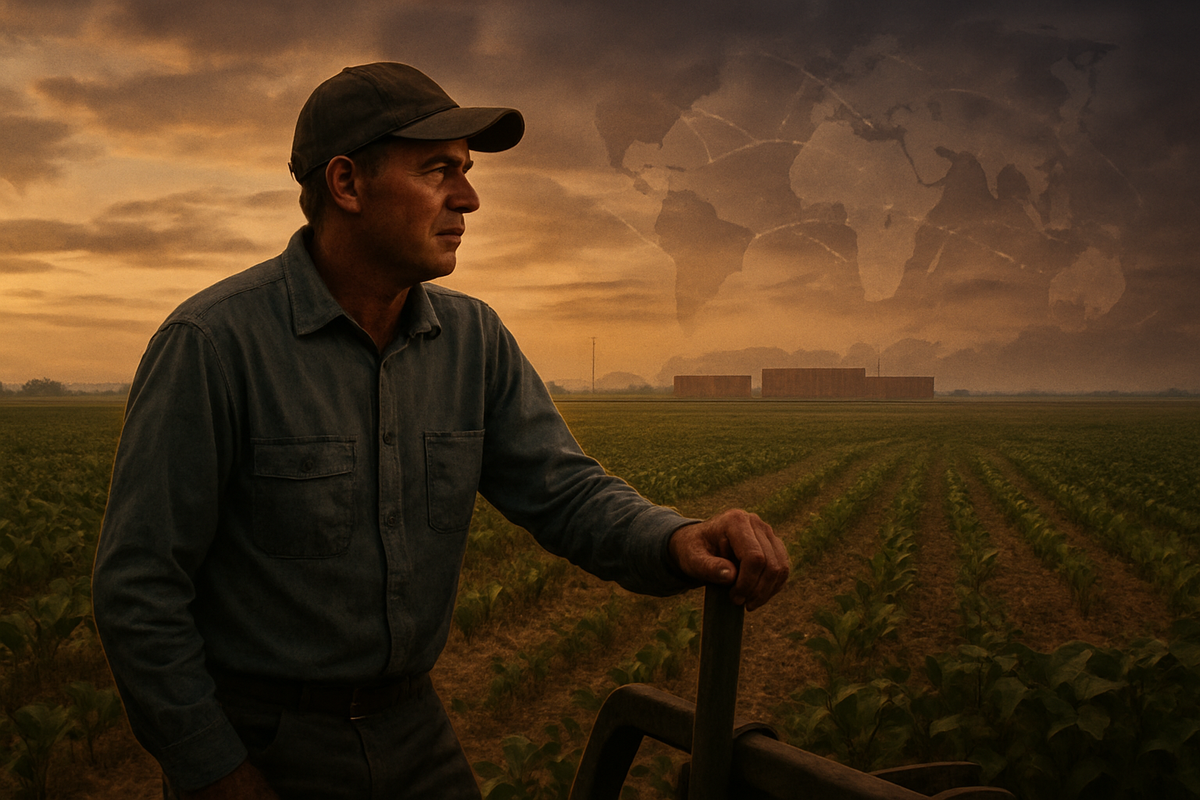
Washington D.C., October 10, 2025 – Across the heartland, a growing chorus of American farmers, particularly in pivotal agricultural states like Illinois, is voicing profound skepticism that government bailouts offer a sustainable solution to the persistent market and trade issues plaguing the agricultural sector. While acknowledging the immediate relief provided by such aid, farmers are increasingly demanding long-term, market-based strategies over what they perceive as temporary "Band-Aids" that fail to address the root causes of their financial distress.
This widespread sentiment among farmers signals a significant shift in the discourse surrounding agricultural policy. It highlights a deep-seated desire for stable and fair global markets, robust trade agreements, and predictable policy frameworks, rather than ad hoc government interventions. The immediate implication is a heightened pressure on policymakers to develop comprehensive and enduring solutions that foster economic resilience for the agricultural community, moving beyond reactive financial assistance.
A Troubled Harvest: Unpacking the Roots of Discontent
The skepticism among US farmers is not a sudden development but rather the culmination of years of market volatility, geopolitical tensions, and inconsistent policy support. A significant timeline of events has shaped this sentiment:
The US-China trade war, which escalated in early 2018 with reciprocal tariffs on billions of dollars worth of goods, severely disrupted critical export markets for American agricultural products, especially soybeans. China, a major buyer, significantly reduced its purchases from the US, turning instead to South American suppliers. In response, the USDA introduced the Market Facilitation Program (MFP), a multi-billion-dollar aid package, first in August 2018 ($12 billion) and again in May 2019 (up to $14.5 billion), to compensate farmers for their losses. While providing temporary relief, many farmers openly expressed a preference for "markets, not aid," finding it difficult to plan amidst shifting trade policies. The total government aid for trade-related losses between 2018 and 2020 accumulated to nearly $28 billion.
Further exacerbating uncertainty has been the protracted delay in passing a new Farm Bill. The extension of the 2018 Farm Bill expired in October 2023, leaving farmers without updated policies reflecting current production costs and market realities. This legislative limbo impacts crucial programs like crop insurance and disaster assistance, creating immense anxiety for farmers planning their 2025 crop year. Agricultural organizations, including the American Farm Bureau Federation (AFBF) and the National Farmers Union (NFU), have consistently lobbied for a comprehensive Farm Bill that provides stability and avoids reverting to outdated regulations.
Adding to the instability, early 2025 saw unexpected cuts to federal funding for agricultural programs. Notably, $1 billion was cut from initiatives enabling schools and food banks to purchase local produce, impacting programs like the Local Food for Schools and Local Food Purchase Assistance Cooperative Agreement. These cuts directly affected local farmers who had integrated these programs into their market strategies, further eroding trust in the consistency of government support. These events collectively underscore a pervasive feeling among farmers that short-term financial interventions do not address the systemic issues that make their livelihoods precarious, leading to a strong demand for proactive, sustainable solutions.
Corporate Crossroads: Winners and Losers in a Shifting Landscape
The prevailing sentiment among farmers, coupled with ongoing trade challenges and policy uncertainty, creates a complex environment for public companies operating within the agricultural sector.
Companies primarily focused on agricultural machinery, such as Deere & Company (NYSE: DE), AGCO Corporation (NYSE: AGCO), and CNH Industrial (NYSE: CNHI), are particularly vulnerable. Farmers, facing tight margins and skepticism about long-term profitability, are deferring significant capital investments in new equipment. Instead, many opt for repairing existing machinery or purchasing used equipment, directly impacting the revenue and profit margins of these manufacturers. Deere, for example, has repeatedly adjusted its profit outlook downward, citing weak crop demand and farmer caution. Tariffs on steel and aluminum further increase production costs, squeezing these companies from both ends.
Similarly, seeds and chemicals companies, like Corteva Agriscience (NYSE: CTVA), face headwinds. While essential, farmers' tightened budgets lead to reduced demand for higher-margin products or a shift towards more economical alternatives. Corteva has experienced competitive pricing pressures, and the uncertainty surrounding global crop demand due to trade policies adds another layer of complexity.
Food processing companies, such as Tyson Foods (NYSE: TSN), also navigate a challenging landscape. Retaliatory tariffs on American pork and other meats have historically caused commodity prices to plunge, eroding profitability in their protein segments. While Tyson's integrated model offers some control, it also exposes the company directly to the volatility of global trade disputes and oversupply issues.
Conversely, global grain trading companies, including Archer-Daniels-Midland (ADM) (NYSE: ADM) and Bunge Limited (NYSE: BG), may be better positioned to mitigate losses, though they are not immune to market disruptions. Their extensive global operations allow them to pivot sourcing and sales to different regions, such as increasing soybean shipments from South America when US exports to China are hampered. In times of policy uncertainty, their proprietary market intelligence and vast inventories can provide a competitive advantage over smaller players. Furthermore, potential government support for domestic biofuel production could boost processing margins for these agribusiness giants.
Generally, companies with highly diversified global operations and flexible supply chains are better equipped to navigate the current environment, adapting to shifts in trade flows and policy changes more effectively than those heavily reliant on specific markets or domestic policies.
Beyond the Bailout: Wider Implications for American Agriculture
The skepticism about government bailouts is not merely a financial complaint; it reflects deeper trends and structural issues within American agriculture. It underscores a fundamental desire among farmers for genuine market stability and fair pricing, rather than reliance on what many perceive as political appeasement.
This sentiment is deeply intertwined with the ongoing trend of farm consolidation. Persistent financial strain, exacerbated by high input costs and weak commodity prices, pushes smaller and mid-sized farms out of business, with their assets often absorbed by larger, more corporate entities. While bailouts offer temporary reprieve, they do not halt this long-term trend, which leads to fewer, but larger, farming operations and increasing concentration of power in the agricultural supply chain.
The ripple effects extend to international trade relations. When US trade policies lead to retaliatory tariffs, as seen with the US-China trade war, it allows competitor nations like Brazil and Argentina to capture US market share, which is often difficult to regain. This damages the US's reputation as a reliable trading partner and can lead to long-term harm to the export industry. Domestically, inconsistent federal funding, such as the freezing of conservation programs, destabilizes farmers who have already committed to projects, impacting local economies.
For future Farm Bills, the current skepticism demands a shift from reactionary aid to proactive, comprehensive policy. Farmers are urgently calling for legislation that reflects modern production costs, strengthens safety nets like crop insurance, and prioritizes market access. The political paradox of farmers voting for administrations whose policies may necessitate bailouts, which they then criticize, highlights the complex interplay of economic interests and political affiliations in rural America.
Historically, the US agricultural sector has a long history of government intervention, from the Great Depression-era policies to the 1970s and 1980s farm crises, which saw programs like Payment-in-Kind (PIK) to manage oversupply. The recent MFP bailouts during the Trump administration's trade wars drew clear parallels, with farmers consistently expressing a preference for open markets over government checks. These historical precedents underscore that while government aid can be a necessary short-term lifeline, it rarely resolves underlying structural issues without accompanying policy reforms.
The Path Ahead: Navigating Uncertainty in the Fields
The future of US agriculture will be defined by its ability to adapt to a landscape characterized by persistent trade challenges, policy unpredictability, and a clear demand from farmers for sustainable solutions.
In the short-term, farmers are focused on stringent cost management, including meticulous evaluation of input purchases (seeds, chemicals, fertilizers), and prioritizing repairs over new equipment investments. Many are exploring short-term debt and considering shifts to crops with higher domestic demand to reduce reliance on export-sensitive commodities. Agricultural organizations continue to advocate for immediate "bridge payments" to maintain liquidity, but with an insistent call for broader policy reforms.
The long-term possibilities point towards significant structural changes. Diversification of income streams will become increasingly crucial, with farmers exploring alternative crops, integrating livestock, or venturing into agritourism. There will be an accelerated adoption of precision agriculture, automation, and robotics to enhance efficiency and reduce labor and input costs. The widespread embrace of sustainable and regenerative farming practices will not only improve environmental resilience but also offer long-term cost savings. Market diversification beyond traditional buyers, with an emphasis on new export destinations in Africa, Latin America, and Asia, will be key, supported by initiatives like the USDA's Regional Agricultural Promotion Program (RAPP). Additionally, exploring value-added processing within the US could enable farmers to capture a larger share of the profit margin.
Strategic pivots for agribusinesses will involve leveraging data-driven decision-making, investing in supply chain resilience, and adapting product offerings to support climate-smart practices. Addressing persistent labor shortages through automation and effective immigration policies will also be critical.
Market opportunities include growing consumer demand for sustainably produced and organic foods, new export markets in emerging economies, and increased demand for climate-smart agriculture products and biofuel feedstocks. However, significant challenges persist: the ongoing cost-price squeeze, widening trade deficits, severe climate change impacts, labor shortages, and limited access to capital for smaller farms.
Potential scenarios range from continued financial strain and accelerated consolidation, leading to fewer but larger corporate farms, to a technology-led transformation resulting in a highly efficient and resilient sector. A reorientation of global trade could force US agriculture to strategically adapt to diversified export markets, while severe policy missteps or unchecked climate impacts could lead to significant disruptions in the food supply. The ultimate outcome hinges on the collective ability of policymakers, agribusinesses, and farmers to implement comprehensive, adaptive strategies that address economic pressures, trade dynamics, policy unpredictability, and environmental challenges simultaneously.
Final Thoughts: A Call for Stability and Strategic Vision
The widespread skepticism among US farmers regarding government bailouts is a powerful indicator of their desire for a stable, predictable, and market-driven agricultural economy. While temporary aid has offered critical lifelines during crises, it is no substitute for robust trade policies, a comprehensive and timely Farm Bill, and a commitment to fostering long-term profitability.
Moving forward, the market will be shaped by the imperative for resilience. Investors should watch for companies that are strategically diversified, investing in advanced agricultural technologies, and capable of adapting their supply chains to global shifts. The emphasis will be on efficiency, sustainability, and the ability to navigate geopolitical complexities. Policies that promote fair trade, invest in agricultural research and infrastructure, and support sustainable farming practices will be crucial for the lasting health of the sector. The current environment is a clear call to action: to move beyond stop-gap measures and build an agricultural future that is both prosperous and resilient for all.
This content is intended for informational purposes only and is not financial advice






